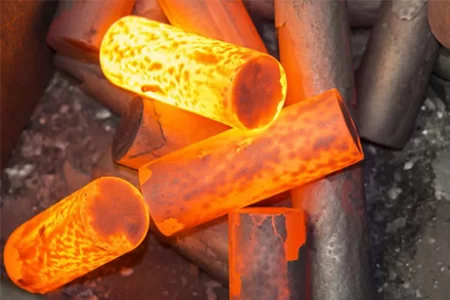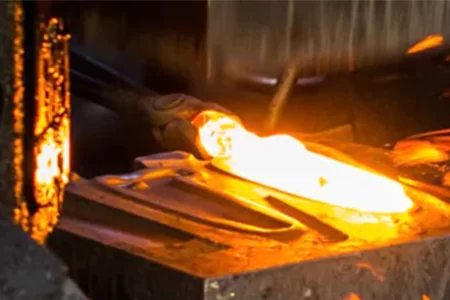In the field of metal processing, forging is an important manufacturing process that plastically deforms metal billets by applying pressure to ultimately obtain products of the desired shape and performance.

Hulk Metal Forging News
Share what's new
Difference between hot forging and cold forging

In the field of metal processing, forging is an important manufacturing process that plastically deforms metal billets by applying pressure to ultimately obtain products of the desired shape and performance. Forging processes are mainly divided into two categories: hot forging and cold forging. Although they both involve plastic deformation of metals, there are significant differences in processing temperature, process flow, material properties, and final product performance. This article will explore the differences between hot forging and cold forging in detail to help readers better understand these two forging methods and their applications.
Hot Forging
Overview
Hot forging refers to a forging process performed under high-temperature conditions, usually above the recrystallization temperature of the metal. Under this high-temperature environment, metal materials have higher plasticity and lower deformation resistance, making it easy to achieve forgings of complex shapes.
Process Flow
The hot forging process usually includes the following steps:
1. Heating: The metal billet is heated to a certain temperature, usually above the recrystallization temperature. Different materials have different heating temperatures. For example, the heating temperature of steel is generally between 1100°C and 1200°C.
2. Forging: At high temperatures, the metal blank is formed by plastic deformation through a press or hammer. During hot forging, the metal has good fluidity and can achieve a large deformation.
3. Cooling: After forging, the forging needs to be cooled. The cooling method can be natural cooling or controlled cooling through water quenching, oil quenching, etc. to achieve the required metallographic structure and mechanical properties.
Advantages
High plasticity: Under high-temperature conditions, the plasticity of metal materials is significantly improved, easy to form, and suitable for processing forgings with complex shapes.
Low deformation resistance: During hot forging, the deformation resistance of the metal is reduced, which helps to reduce the load and energy consumption of the equipment.
Improved material properties: Through hot forging and subsequent heat treatment, the mechanical properties of the metal, such as strength, toughness, and hardness, can be significantly improved.
Disadvantages
Oxidation and decarburization: Under a high-temperature environment, oxidation and decarburization are prone to occur on the metal surface, which affects the surface quality and performance of the forging.
Low dimensional accuracy: During hot forging, the volume expansion and contraction of the metal is large, resulting in low dimensional accuracy of the forging.
High energy consumption: Due to the need to heat the metal at high temperature, the energy consumption of the hot forging process is high.
Cold forging
Overview
Cold forging is a forging process performed at room temperature or slightly above room temperature. Due to the large deformation resistance during cold forging, larger pressure equipment is usually required, but high-precision and high-strength forgings can be obtained.
Process flow
The cold forging process usually includes the following steps:
1. Pretreatment: Pretreat the metal blank, such as removing the oxide scale, lubrication, etc., to reduce friction and wear during forging.
2. Forging: At room temperature or slightly higher temperature, high pressure is applied to the metal blank through a press to cause it to undergo plastic deformation.
3. Post-processing: Surface treatment, heat treatment, or further processing are performed on the cold forgings as needed to meet the final product requirements.
Advantages
High precision: Cold forging is carried out at room temperature, the thermal expansion and contraction of the metal is small, and the dimensional accuracy of the forgings is high.
Good surface quality: The surface finish of cold forgings is high, and oxidation and decarburization are not easy to occur.
High material utilization rate: The fluidity of the material during cold forging is low, there is less waste, and the material utilization rate is high.
Excellent mechanical properties: Due to the work-hardening effect during cold forging, the strength and hardness of the forgings are significantly improved.
Disadvantages
High deformation resistance: The deformation resistance during cold forging is large, and high-power forging equipment and good lubrication conditions are required.
Material limitations: Cold forging is suitable for metal materials with good plasticity, such as aluminum alloys, copper alloys and low-carbon steel, but not for high-strength, low-plasticity materials.
Processing complexity: The plastic deformation during cold forging is small, and it is difficult to achieve forgings with complex shapes.
Application scenarios
Application of hot forging
Hot forging is widely used in the manufacture of large, complex-shaped, and high-strength forgings, such as tensioners. Due to the good mechanical properties and fatigue strength of hot forgings, they perform well in high-load and high-temperature environments.
Application of cold forging
Cold forging is mainly used to produce small, high-precision, and high-strength parts, such as fasteners, gears, bearings, etc. Due to the good surface quality and high dimensional accuracy of cold forgings, they are widely used in industries such as machinery, electronics, and home appliances.
Hot forging and cold forging are two important metal processing processes, each with its own unique advantages and application areas. Hot forging is suitable for large, complex-shaped and high-strength forgings, while cold forging is suitable for small, high-precision, and high-strength parts. In practical applications, the appropriate forging method should be selected according to the specific workpiece requirements, material properties and process conditions to achieve the best processing effect and product performance. Through reasonable process design and optimization, the advantages of hot forging and cold forging can be fully utilized to improve product quality and production efficiency.
Article Navigation
Article Navigation
Industries
Forging Factory




